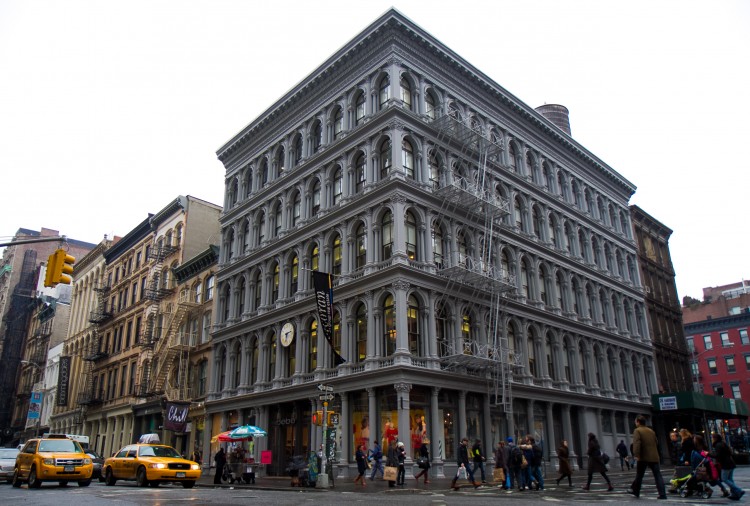E.V. Haughwout Building
488–492 Broadway
Architect: John P. Gaynor with ironwork by Badger Iron Works
Year Built: 1857
When it was constructed in 1857, the E.V. Haughwout building was a mammoth addition to New York’s mostly modest architecture scene. The cast-iron facade for the building was made in renowned Daniel Badger’s Architectural Iron Works. Badger was so proud of his work that he printed a picture of the E.V. Haughwout in his 1865 catalog.
The building was designed by John P. Gaynor. The facade’s design draws from the Biblioteca Sansoviniana in Venice. Its two street-facing sides have 92 windows, each ornamented by a design element repeated throughout: two columns topped by an arch, which is in turn flanked by two larger columns. The columns are termed Serlian and are based on designs by Sebastiano Serlio (1475–1554).
The building was ordered by Eder V. Haughwout, a merchant in china, glassware, silverware, and other upscale tableware and household goods. The store’s bottom three floors were packed with products, while the top two floors housed women who hand painted china and craftsmen who worked on glass cutting and silver plating.
The building’s facade was designed to overwhelm the passerby and the shopper alike. The goods inside were just as luxurious as the facade outside—the Lincoln family purchased a set of china there for the White House. Other famous clients included the czar of Russia and the imam of Muscat. Gifts from Haughwout were also presented to the emperor of Japan and King Rama IV of Siam.
The world’s first passenger elevator was installed in the building by Elisha Graves Otis. It took a full minute to move from the first to the fifth floor. Despite being slow, the elevator sported a locking mechanism that would secure the cabin in place as it ascended, preventing the collapses associated with rope failure. This made the elevator safe for human use. Otis, the company behind the elevator, became the world’s largest elevator company. Its elevators are now in many of New York City’s landmark buildings including the Flatiron, the Singer, the Woolworth, the Chrysler, and the Empire State.
The building remained off the architectural radar as skyscrapers and modern architecture was the talk of the town for decades. In 1965, it was designated a New York City landmark, and in 1973 it was added to the National Register of Historic Places. The ground floor was occupied by office supply retailer Staples, which has recently been replaced by Bebe, a fashion outlet.







